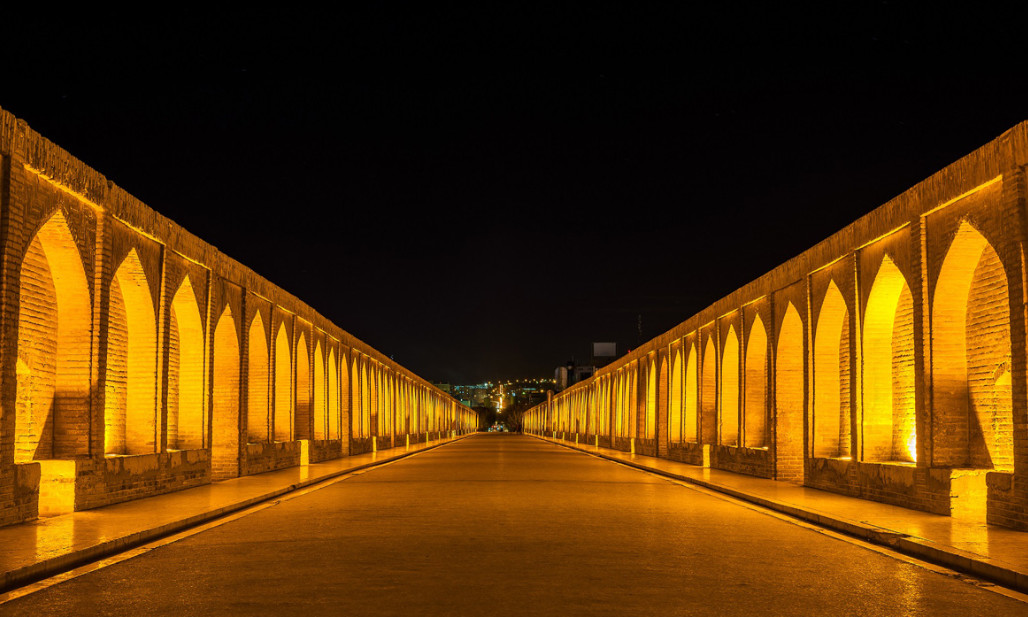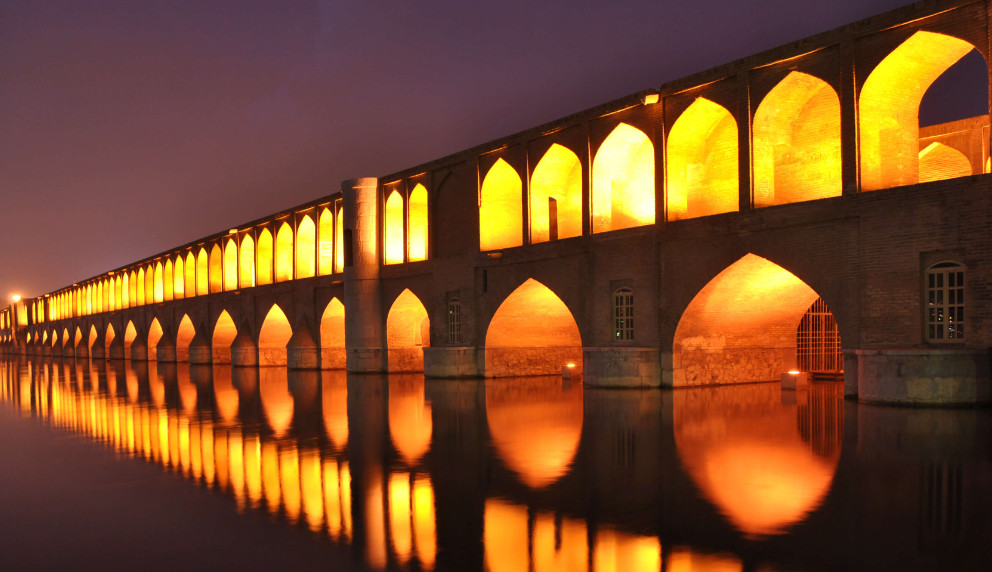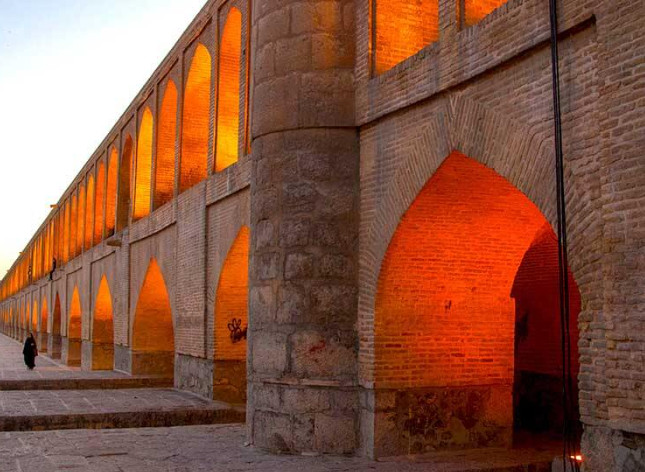Si-o-se-pol : an architectural jewel + video
The city of Isfahan, known historically as “Half the World” due to its unparalleled beauty, is home to some of the most captivating and historically significant monuments in Iran. Of these, the Si-o-se-pol, or the Bridge of Thirty-Three Arches, stands as a resplendent example of Safavid dynasty engineering and design. With a legacy spanning over four centuries, this bridge is not only a testament to Persian architectural prowess, but also a vibrant social and cultural hub for the inhabitants of the city.
Watch the video :
Historical Background
Built between 1599 and 1602 under the patronage of the Safavid king, Shah Abbas I, the Si-o-se-pol was constructed during a period of great cultural and architectural innovation in Iran. Shah Abbas I, intent on making Isfahan the capital of his empire, invested heavily in its development, resulting in some of the most remarkable architectural works of Persian history.
Si-o-se-pol, spanning the Zayandeh River, was one of the eleven bridges constructed in Isfahan during this period. It wasn’t just an infrastructure project, but also an embodiment of Persian art, science, and aesthetic values.

Architectural Marvel
The bridge’s most defining characteristic is, undoubtedly, its thirty-three arches. This number has profound significance in Islamic numerology, and its incorporation into the bridge’s design showcases the seamless blending of function, form, and spirituality.
Crafted from yellow brick and spanning approximately 295 meters in length, the Si-o-se-pol displays unique design principles. Unlike many bridges that adopt a straight path across a river, the Si-o-se-pol is slightly curved, a design feature that lends itself to the aesthetics and stability of the bridge. Its double-decked structure also is significant; the lower deck allows for the ebb and flow of the Zayandeh River, while the upper deck provides pedestrians a pathway, accentuated by alcoves that offer shade and rest.
In terms of its engineering, the bridge showcases an adept understanding of both the material and the environment. The tapered arches, while appearing delicate and graceful, serve to distribute the weight of the bridge effectively, allowing it to endure for centuries.

Social and Cultural Significance
More than just a passage across the river, the Si-o-se-pol quickly became a social and cultural center for the inhabitants of Isfahan. Its construction corresponded with Shah Abbas I’s intention to create public spaces that would foster social interaction and community bonding.
Even today, it’s not uncommon to see people from all walks of life strolling along its pathways. Musicians set up in its alcoves, playing traditional Persian tunes, while locals and tourists alike find solace in its serene atmosphere, often gathering to share tales, poetry, and songs as the river flows beneath them.
The bridge, in many ways, has also become a reflection of the city’s changing socio-cultural dynamics. During periods when the river has dried up, it has turned into a promenade, with people playing soccer, holding picnics, or even conducting yoga sessions on the riverbed below.

Integration with the Environment
The bridge’s harmony with its natural surroundings is notable. The reflection of its thirty-three arches on the calm waters of the Zayandeh River during twilight creates a mesmerizing tableau. The interplay of light and shadow, especially during the golden hours, accentuates its majestic stature.
Moreover, the gardens and trees lining its banks provide a verdant contrast to the yellow brickwork of the bridge, underscoring the age-old Persian love for gardens and green spaces.

Religious and Spiritual Symbolism
Beyond its obvious architectural brilliance, the Si-o-se-pol also carries deep religious and spiritual symbolism. As previously mentioned, the number thirty-three has profound significance in Islamic numerology. In Shi’a Islam, which is predominant in Iran, the number thirty-three has spiritual implications, often linked with the age of Prophet Jesus at his ascension and the number of beads in a tasbih (prayer beads) used for glorification of God post-prayer.
Walking the bridge, one can find traces of inscriptions and art that allude to the spiritual beliefs of the time, turning an architectural marvel into a pathway of reflection and spirituality.
The Si-o-se-pol is more than just a bridge. It is a testament to the rich cultural, architectural, and spiritual heritage of Isfahan and Iran as a whole. Its endurance through the centuries serves as a poignant reminder of the timeless nature of art, the depth of human ingenuity, and the profound impact of culture and history on our built environment.
What does Si-O-Se-Pol mean?
How old is siosepol?
The Si-o-se-pol, or the Bridge of Thirty-Three Arches, was constructed between 1599 and 1602 during the reign of Shah Abbas I of the Safavid dynasty. As of 2023, this would make the Si-o-se-pol approximately 421 years old. It remains one of the most iconic architectural marvels in the city of Isfahan, Iran, showcasing the brilliance of Persian engineering and design from that era.
What materials were used to build the Si O Se Pol bridge?
The Si-o-se-pol bridge in Isfahan, Iran, stands as a testament to Persian architectural ingenuity and craftsmanship during the Safavid era. The primary materials used in the construction of the Si-o-se-pol are:
- Stone and Brick: The foundational structure of the bridge, including its 33 arches, was predominantly built using bricks. These bricks lend the bridge its characteristic yellowish hue. Stone was also used, particularly in the piers supporting the arches, to provide durability and strength.
- Mortar: A binding material made from a mix of lime and sand, mortar played an essential role in holding the bricks and stones together, providing both cohesion and structural strength to the bridge.
- Plaster and Tile Work: While the major part of the bridge is characterized by its brickwork, certain sections of the bridge feature intricate plasterwork and tiles, often used to adorn and add aesthetic appeal. These decorative elements sometimes carried inscriptions or artistic patterns.
- Wooden Sluice Gates: In the original design, the bridge featured wooden sluice gates. These gates were instrumental in regulating the flow of water from the Zayandeh River, ensuring that the river’s water could be used effectively for irrigation and other purposes.
The choice of these materials not only underscores the technical knowledge of the architects and builders of the time but also emphasizes a harmony with the local environment. The materials were sourced locally, ensuring sustainability and reducing the environmental footprint of such a grand construction project. This practice was quite common in ancient architectural projects, where the immediate environment provided most of the construction materials, ensuring that structures blended seamlessly with their surroundings.


